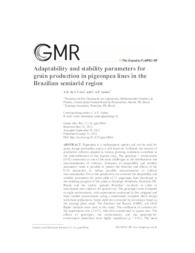Adaptability and stability parameters for grain production in pigeonpea lines in the Brazilian semiarid region.
Adaptability and stability parameters for grain production in pigeonpea lines in the Brazilian semiarid region.
Author(s): COSTA, A. E. da S.; SANTOS, C. A. F.
Summary: Pigeonpea is a multipurpose species and can be used for grain, forage production, and as a soil improver. In Brazil, the scarcity of productive cultivars adapted to various growing conditions contribute to the underutilization of this legume crop. The genotype × environment (G×E) interaction is one of the main challenges to the development and recommendation of cultivars. Estimates of adaptability and stability parameters make it possible to predict the behavior and effects of the G×E interaction to reduce possible inconsistencies in cultivar recommendation. From this perspective, we assessed the adaptability and stability parameters for grain yield of 21 pigeonpea lines developed in the breeding program of this pulse at Embrapa Semiárido, Petrolina, PE, Brazil, and the variety ?guandu Petrolina? (control), in order to recommend new cultivars for general use. The genotypes were evaluated in eight environments, with experiments conducted in five irrigated and three rainfed environments using a randomized complete block design with three replications. Grain yield was corrected by covariance based on the average plant stand. The Eberhart and Russel, AMMI, and GGE Biplot methods were used in this study. The coefficient of variation for the experiments was 12.41%, with data transformed to square root. The effects of genotypes, the environments, and the genotype-by-environment interaction were highly significant (p < 0.01). The mean grain yield of the genotypes was 1,516 kg ha-1. Lines 87, 100, and 158 simultaneously showed wide adaptability and good predictability according to the three methods, with mean yields of 1,530, 1,701, and 1,812 kg ha-1, respectively, and reaching yields of up to 2,725, 2,928, and 2,955 kg ha-1 in some environments. These lines are indicated for recommendation as new pigeonpea cultivars for the semi-arid region of Brazil.
Publication year: 2022
Types of publication: Journal article
Unit: Embrapa Semi-arid Region
Observation
Some of Embrapa's publications are published as ePub files. To read them, use or download one of the following free software options to your computer or mobile device. Android: Google Play Books; IOS: iBooks; Windows and Linux: Calibre.
Access other publications
Access the Agricultural Research Database (BDPA) to consult Embrapa's full library collection and records.
Visit Embrapa Bookstore to purchase books and other publications sold by Embrapa.

